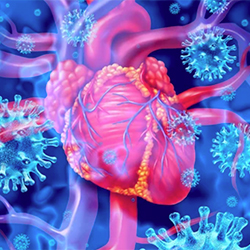By Marie Rosenthal, MS
One in 20 patients with COVID-19 develop new-onset atrial fibrillation (AFib) that is strongly associated with increased in-hospital mortality and major cardiovascular events, according to a new report from the American Heart Association’s (AHA’s) COVID-19 Cardiovascular Disease Registry.
Those who developed new-onset AFib experienced longer hospital stays and had a greater need for ICU care and intubation; approximately 45% died in the hospital (Circ Arrhythm Electrophysiol 2022;15[5]:e10666).

“COVID-19 can cause havoc with the immune system, and it is well known that myocardial and pericardial inflammation can make atrial fibrillation more likely,” explained C. Michael White, PharmD, FCP, FCCP, the Department Head and Distinguished Professor of Pharmacy Practice at the University of Connecticut, in Storrs.
“Atrial fibrillation can both directly increase the risk of stroke and prolonged hospitalization. It is also an indirect marker of the insult that the heart is experiencing when patients are infected with COVID-19,” said Dr. White, who was not part of the study but was asked his opinion. Dr. White is an expert in cardiology.
Using data from the AHA’s registry, researchers examined nearly 28,000 patients without a history of AFib who were hospitalized for COVID-19. After multivariable adjustment for in-hospital factors and underlying comorbidities, the findings suggested new-onset AFib in patients hospitalized with COVID-19 is a marker of adverse clinical factors.
“In 2001, experts predicted the number of Americans living with AFib would double by 2050—the situation may be more dire following the COVID-19 pandemic,” said Jonathan Piccini, MD, MHS, FACC, FAHA, FHRS, the volunteer chair of the AHA Atrial Fibrillation Systems of Care Advisory Group.
“Research suggests AFib is likely to influence more Americans and could put more people at greater risk of stroke and heart failure than previously expected,” added Dr. Piccini, who is a cardiac electrophysiologist and an associate professor at Duke University Medical Center, Durham, N.C.
“Effective anti-inflammatory therapies can help but the best defense against these negative sequalae is to be vaccinated against the disease. Pharmacists have done an amazing job getting the hospitalizations down, especially in high-risk people. But with the omicron variant, we have to get our highest risk patients back to receive their new bivalent boosters. So, when you see them for regular refills, let them know about the importance of boosting their protection,” Dr. White said.
In related news, data from Israel found that myocarditis after COVID-19 vaccination remains rare, but the highest risk is in young males.
A new study from Israel found that the risk for developing myocarditis among males ages 16 to 19 years was about one in 15,000 after a third dose of the Pfizer-BioNTech COVID-19 vaccine, and the cases were rare and mild (Circulation 2022;146[10]:802-804).
Typically thought to be triggered by a viral infection, myocarditis is the inflammation of the middle layer of the wall of the heart muscle, the myocardium. This condition is uncommon and may temporarily or permanently weaken the heart muscle and the heart’s electrical system. An episode of myocarditis may resolve on its own or with treatment, or may result in lasting damage to the heart.
In the general population and not during a pandemic, it is estimated that approximately 10 to 20 people per 100,000 are diagnosed with myocarditis each year, according to the AHA’s 2021 scientific statement on myocarditis (Circulation 2021;144[6]:e123-e135).
Research detailing post-vaccination myocarditis in Israel after the first and second doses of the Pfizer-BioNTech COVID-19 vaccine have been published by the country’s Ministry of Health. The incidence rate of myocarditis was low; however, it was primarily in young males and most cases resulted after a second COVID-19 vaccination, suggesting a potential relationship between the vaccine and myocarditis.
The results raised concerns about the potential for increased myocarditis after a booster dose; therefore, this new analysis was focused on the risk for myocarditis after a booster dose.
“It is important to understand the connections between this rare heart condition and COVID-19 vaccines, so we can monitor the prevalence of myocarditis and pay extra attention to those who are most at risk,” said lead study author Dror Mevorach, MD, a professor of medicine and the head of Immunology-Rheumatology Institution at Hadassah Ein Karem Medical Center and the chairman of the Israeli Ministry of Health Committee for Identifying Myocarditis as an Adverse Effect of mRNA Vaccines, in Jerusalem.
From July 31 to Nov. 5, 2021, nearly 4 million adults in Israel received a booster dose of the Pfizer-BioNTech vaccine, about half (48.7%) of whom were males. Health data for all reported cases of myocarditis after receiving the Pfizer-BioNTech COVID-19 vaccine were evaluated. A cardiologist and rheumatologist reviewed and classified the data based on the Brighton Collaboration Myocarditis Case Definition.
The analysis found that after a 30-day follow-up:
- fewer than 100 cases (91) of myocarditis were reported, including 35 cases that occurred within the first 30 days of receiving a COVID-19 booster (a third dose) of the Pfizer-BioNTech COVID-19 vaccine;
- 28 cases of myocarditis were probable or confirmed, and 18 occurred within the first seven days after receiving the booster dose of the Pfizer-BioNTech vaccine;
- all 28 cases of myocarditis were clinically defined as mild, and individuals recovered within an average of 3.5 days in the hospital;
- among all age groups, the risk rates of developing myocarditis were nearly nine times higher in males than in females (1.42 vs. 0.16); and
- males ages 16 to 19 years were at the highest risk, with six in 100,000 individuals developing myocarditis, followed by males ages 20 to 24 (5.21 cases per 100,000), 30 to 39 (1.81 cases per 100,000) and 25 to 29 years(0.79 cases per 100,000).
The risk differences declined significantly between the second and third vaccine doses across both genders and across all age groups. The epidemiologists believe there are two potential explanations for the changes. “The first is that individuals who developed myocarditis after the second COVID-19 vaccine dose did not receive a third shot, which was a medical precaution in Israel. The second potential explanation is the interval of time between doses: First and second doses are administered approximately three weeks apart; however, the time between a second dose and a booster was about 20 to 24 weeks,” Dr. Mevorach said.
More research is needed to better explain what may predispose young males to develop myocarditis after a COVID-19 vaccine and the pathophysiologic mechanisms involved.




